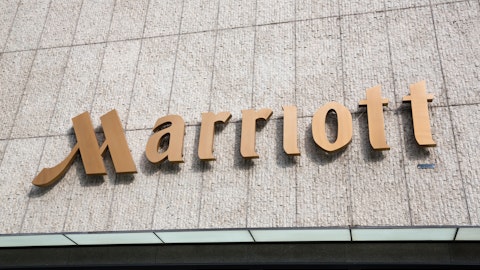Timothy Arcuri: Jensen, I had a question about what this all does to your TAM. Most of the focus right now is on text, but obviously, there are companies doing a lot of training on video and music. They’re working on models there. And it seems like somebody who’s training these big models has maybe, on the high end, at least 10,000 GPUs in the cloud that they’ve contracted and maybe tens of thousands of more to inference a widely deployed model. So it seems like the incremental TAM is easily in the several hundred thousands of GPUs and easily in the tens of billions of dollars. But I’m kind of wondering what this does to the TAM numbers you gave last year. I think you said $300 billion hardware TAM and $300 billion software TAM. So how do you kind of think about what the new TAM would be?
Jensen Huang: I think those numbers are really good anchor still. The difference is because of the, if you will, incredible capabilities and versatility of generative AI and all of the converging breakthroughs that happened towards the middle and the end of last year, we’re probably going to arrive at that TAM sooner than later. There’s no question that this is a very big moment for the computer industry. Every single platform change, every inflection point in the way that people develop computers happened because it was easier to use, easier to program and more accessible. This happened with the PC revolution. This happened with the Internet revolution. This happened with mobile cloud. Remember, mobile cloud, because of the iPhone and the App Store, 5 million applications and counting emerged.
There weren’t 5 million mainframe applications. There weren’t 5 million workstation applications. There weren’t 5 million PC applications. And because it was so easy to develop and deploy amazing applications part cloud, part on the mobile device and so easy to distribute because of app stores, the same exact thing is now happening to AI. In no computing era did 1 computing platform, ChatGPT, reached 150 million people in 60, 90 days. I mean, this is quite an extraordinary thing. And people are using it to create all kinds of things. And so I think that what you’re seeing now is just a torrent of new companies and new applications that are emerging. There’s no question this is, in every way, a new computing era. And so I think this — the TAM that we explained and expressed, it really is even more realizable today and sooner than before.
Operator: Your next question comes from the line of Stacy Rasgon with Bernstein.
Stacy Rasgon: I have a clarification and then a question both for Colette. The clarification, you said H-100 revenue’s higher than A100. Was that an overall statement? Or was that at the same point in time like after 2 quarters of shipments? And then for my actual question. I wanted to ask about auto, specifically the Mercedes opportunity. The Mercedes had an event today, and they were talking about software revenues for their MB Drive that could be single digit or low billion euros by mid-decade and mid billion euros by the end of the decade. And I know you guys were supposedly splitting the software revenues 50-50. Is that kind of the order of magnitude of software revenues from the Mercedes deal that you guys are thinking of and over that similar time frame? Is that how we should be modeling that?
Colette Kress: Great. Thanks, Stacy, for the question. Let me first start with your question you had about H-100 and A100. We began initial shipments of H-100 back in Q3. It was a great start. Many of them began that process many quarters ago. And this was a time for us to get production level to them in Q3. So Q4 was an important time for us to see a great ramp of H-100 that we saw. What that means is our H-100 was the focus of many of our CSPs within Q4, and they were all wanting to get both get up and running in cloud instances. And so we actually saw less of A100 in Q4 of what we saw in H-100 at a larger amount. We tend to continue to sell both architectures going forward, but just in Q4, it was a strong quarter for Your additional questions that you had on Mercedes Benz.
I’m very pleased with the joint connection that we have with them and the work. We’ve been working very diligently about getting ready to come to market. And you’re right. They did talk about the software opportunity. They talked about their software opportunity in 2 phases, about what they can do with Drive as well as what they can also do with Connect. They extended out to a position of probably about 10 years looking at the opportunity that they see in front of us. So it aligns with what our thoughts are with a long-term partner of that and sharing that revenue over time.





